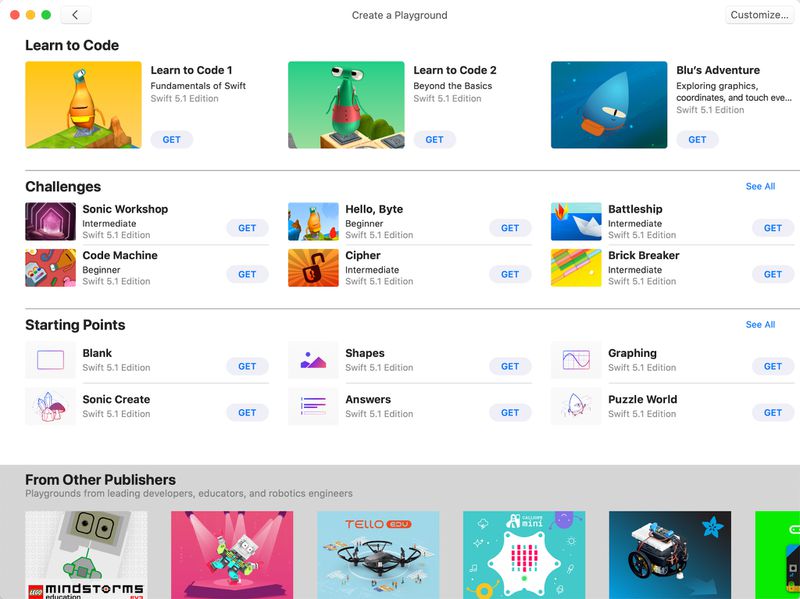
- #MAC ALTERNATIVE FOR SWIFT PLAYGROUNDS APP CODE#
- #MAC ALTERNATIVE FOR SWIFT PLAYGROUNDS APP PLUS#
- #MAC ALTERNATIVE FOR SWIFT PLAYGROUNDS APP PROFESSIONAL#
- #MAC ALTERNATIVE FOR SWIFT PLAYGROUNDS APP TV#
Get them to open the MeeBot Dances playground which you downloaded before, which lets you program a virtual MeeBot character to dance. Once students have completed the puzzles, they’ll be able to apply coding principles to other functions.
#MAC ALTERNATIVE FOR SWIFT PLAYGROUNDS APP CODE#
Part 3: Apply code to a MeeBot Dances video Guide students through these puzzles to move the Byte character around his little world, but let them try figuring the solutions out for themselves first. There are then four puzzles on the next page to complete: Issuing Commands Adding a New Command Composing a New Behaviour, and Creating a New Function. The eight slide Introduction reinforces what you previously taught the class about the fundamentals of code with real world examples. Get them to open the app on their iPad and load up the Learn to Code 1 playground. Now, students can try out Swift Playgrounds themselves. In Swift programming language, this command is makeFortuneTeller(). This shows how the process of them making their fortune teller can be split up into separate steps which act as a command. Now they have grasped the reasoning behind commands and functions, you can advance to slide 4. This example is all about being told to brush your teeth, which in code could be formatted as 'brushTeeth()'. Slide 3 explains how steps can be put together to create a command that performs a function. Run them through slide 2 and ask them to create a paper fortune teller using the instructions on screen. The first part of the session focuses on commands and functions.
#MAC ALTERNATIVE FOR SWIFT PLAYGROUNDS APP PLUS#
When you're ready to start, open the presentation and give a brief introduction to code and what it's used for in the real world, plus a rundown of Swift Playgrounds and what the class will be doing during the session. Open Swift Playgrounds and Find the Learn to Code 1 and MeeBot Dances projects from the list below (subscribe to UBTech Jimu Robots from the From Other Publishers section). A display at the front of the class will let you guide students through, and this teacher guide from Apple will guide you through the Hour of Code session. It's recommended that every student has an individual iPad to get the best experience, but you could feasibly have one device between two. You'll first need to download the Swift Playgrounds app from the App Store, which requires a 64-bit iPad with iOS 10 or later or iPadOS and on a Mac, MacOS. What you’ll needīefore you start, make sure you've got all the necessary kit.


#MAC ALTERNATIVE FOR SWIFT PLAYGROUNDS APP PROFESSIONAL#
It’s designed for students aged eight and over, and helps you introduce coding in the same language used by professional app developers. Swift Playgrounds is an app that teaches coding using interactive puzzles and colourful characters.

#MAC ALTERNATIVE FOR SWIFT PLAYGROUNDS APP TV#
Swift is Apple's own programming language, used by professionals to create apps for the Apple ecosystem, including iPad, Mac, iPhone, Apple TV and Apple Watch. Here, we guide you through it step by step, from a simple introduction through to getting students to create their own dancing robot animation in MeeBot Dances! What is Swift Playgrounds? This is now available as a free download on Mac and the iPad. If you're new to coding in the classroom, Swift Playgrounds' 'Learn to Code 1' module is the ideal starting point, intended to introduce the fundamentals of code in an accessible way, in just one hour. As a result of the pandemic there has been a rise of iPads in schools, and many institutions no longer require UIT suites for coding as they can do everything on the devices, saving money on extra technology. And with the rise of mobile devices in schools, it's now easy to do.Ĭoding was a big focus of Apple at the BETT 2020, and last year they updated and expanded their 'Everyone Can Code' curriculum to help introduce more primary school students to the world of coding, with heaps of resources for teachers and students. With the basics of coding and programming a key requirement in the National Curriculum's computing programme of study right from Key Stage 1, it's never too early to introduce code to the classroom.


 0 kommentar(er)
0 kommentar(er)
